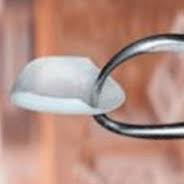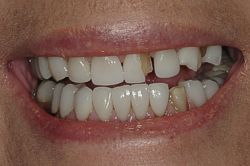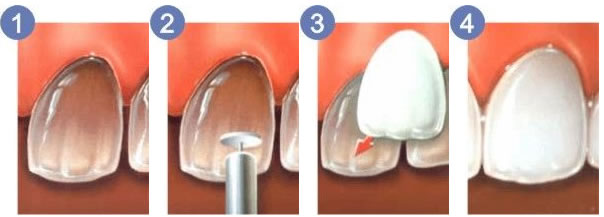A dental veneer is a very thin, tooth-colored shell that fits over the front surface of a tooth, in order to improve its appearance. It is routinely used for teeth that are discolored, chipped, worn or damaged. Dental Veneers can also be used to close unwanted spaces between teeth or improve the alignment and/or shape of teeth, in order to improve the appearance. Veneers are commonly used in Cosmetic dentistry as it is a very effective way to improve someone’s smile and can provide a great, natural looking appearance, often with little preparation or damage to the original teeth. They generally last between 5 and 10 years.

Dental Veneer
Veneers are usually made from porcelain, which looks great and mimic the light reflecting properties of natural teeth. Porcelain veneers are stain resistant and will therefore continue to look great, provided good oral hygiene is maintained.

Porcelain Veneer
Composite resin can also be used for dental veneers. The big advantage is that less tooth preparation, if any is required and it is relatively quick and affordable to place. If a piece chips, some composite can be added, without having to replace the complete veneer. Unfortunately composite material can discolor over time and may need polishing or even replacement if it discolors too much.
Advantages of Dental Veneers
- Aesthetic, natural looking results: The veneers are customized for your particular teeth and requirements and can greatly improve the appearance of your teeth.
- Color match to existing teeth: You do not need to veneer all your teeth as the veneer can be made to match the color of your other teeth very closely. Porcelain veneers are also stain resistant.
- Gum friendly: The gingival tissue (gums) tolerates porcelain very well
- Conservative: Less tooth structure need to be removed in order to do veneers than with crowns. With minimal invasive veneers and composite veneers, there is often virtually no alteration to the original teeth required.
- Quick, dramatic results: Composite veneers can be done in a single visit to your dentist and porcelain veneers in two visits. A very dramatic result can be seen as soon as the veneers have been placed. In comparison it may take months/years for orthodontic treatment to improve problems like misalignment of teeth and spaces between them.
- Multiple flaws can be corrected: A range of flaws in a person’s teeth can all be corrected by using veneers. They can treat chips, small fractures and staining. Unwanted spaces between teeth can be closed and the shape and position of teeth can be improved.
- Looks good in combination with crowns, bridges and implants: The porcelain of veneers matches that of crowns and bridges and will therefore look great when a combination of indirect treatment options is used. Veneers are often an important part of a comprehensive cosmetic dentistry treatment plan.
- Easy maintenance: Apart from maintaining very good oral hygiene and your regular dental check-ups, no special maintenance is required.

Veneers: Before and After
Disadvantages of Dental Veneers
- Porcelain veneers can chip or fracture. If a veneer fractures, it cannot be repaired and needs replacing. Care needs to be taken to prevent veneers from fracturing by refraining from chewing hard objects such as pencils or finger nails
- Veneers can dislodge: Although it doesn’t happen frequently, veneers can debond and fall off.
- Only suitable for placement on relatively healthy teeth: Veneers are not suitable for teeth with decay, large fractures or multiple fillings. These teeth will benefit from full crowns instead. There should be adequate enamel on the tooth surface for optimum results. Gum disease must be treated before veneers are done.
- Porcelain veneers are irreversible and cannot be altered ones placed: It is extremely important to make sure the size, shape and color is perfect, as it cannot be altered. Tell the dentist before he bonds the veneer in place if you are not satisfied so the veneer can be remade. If you decide on tooth whitening after the veneers have been placed, the veneers will not bleach and you may end up with veneers that do not match your other teeth anymore.
- Sensitivity after preparation: In order to prepare a tooth for a veneer, enamel is removed which may cause some sensitivity to hot and cold. Fortunately this is usually temporary.
- Not suitable for people who grind their teeth or for very misaligned teeth: Veneers are very thin porcelain shells and can fracture if a person bites too hard on them, therefore the risk of veneers failing in people who grinds their teeth are high.
- Decay still possible: The teeth with veneers can still decay. Good oral hygiene must be maintained.

Fractured Veneer
Procedure
- Consultation: You will need to see your dentist first to discuss the problems with your teeth, as well as your expectations.
- Diagnosis and treatment planning: Your dentist will examine your teeth to determine what the treatment options are. In some cases, veneers may not be an appropriate choice. The dentist may take x-rays and in some cases even impressions for study models. After careful evaluation he/she will discuss the treatment plan with you. The treatment may even involve a combination of teeth whitening, veneers and crowns. Ensure that you fully understand what the treatment will involve, the alternatives, benefits, disadvantages and cost before you proceed.
- Veneer preparation: Your dentist may anaesthetize the tooth, depending on how much trimming the tooth requires and the sensitivity of the tooth. Usually about 0.5 mm enamel from the tooth surface needs removal, but this depends a lot on the shape, position and shade of the tooth. Impressions will then be taken of your teeth and sent to the dental laboratory, which will make the veneer. In some cases, a temporary veneer can be placed as it usually takes between one and two weeks for the laboratory to construct the veneer.
- Fitting the Veneer: Once the dental veneer is back from the laboratory, the dentist will see you again. The temporary veneer will be removed. Your dentist will check to see if the new veneer fits properly and has the desired shape and shade. The tooth will then be cleaned thoroughly before an acid is placed on the tooth surface in order to etch it. He/she will rinse away the acid after a few seconds and gently dry the tooth. Special cement, with color to match your teeth, will then be used to bond the veneer to the tooth. A light will be used to activate the chemicals in the cement and harden it. Any excess cement will be removed and final adjustments can be done.
- After care: Visit your dentist every six months for check-ups and thorough cleaning. Take care to maintain good oral hygiene. Do not bite hard objects like finger-nails or pencils and certainly do not open bottle caps with your teeth as veneers can fracture.

Dental Veneer Procedure